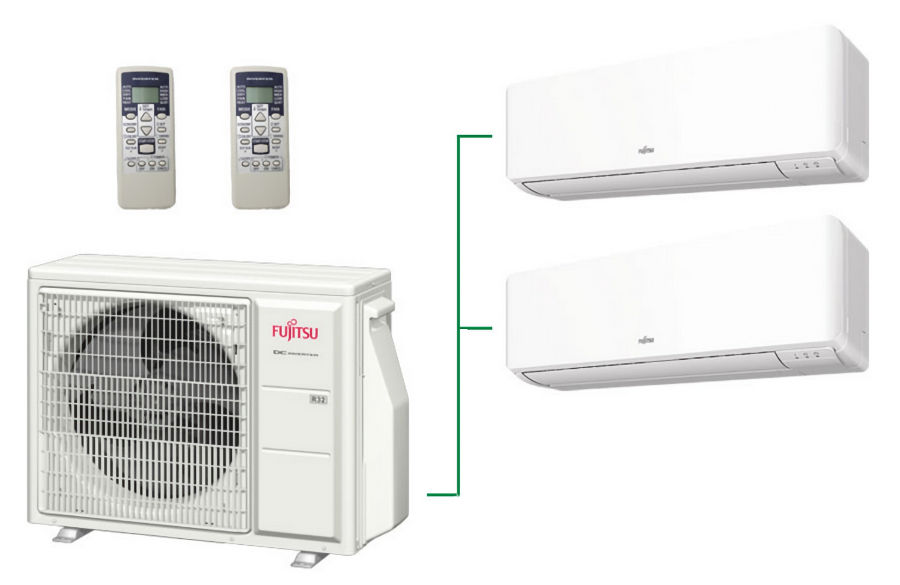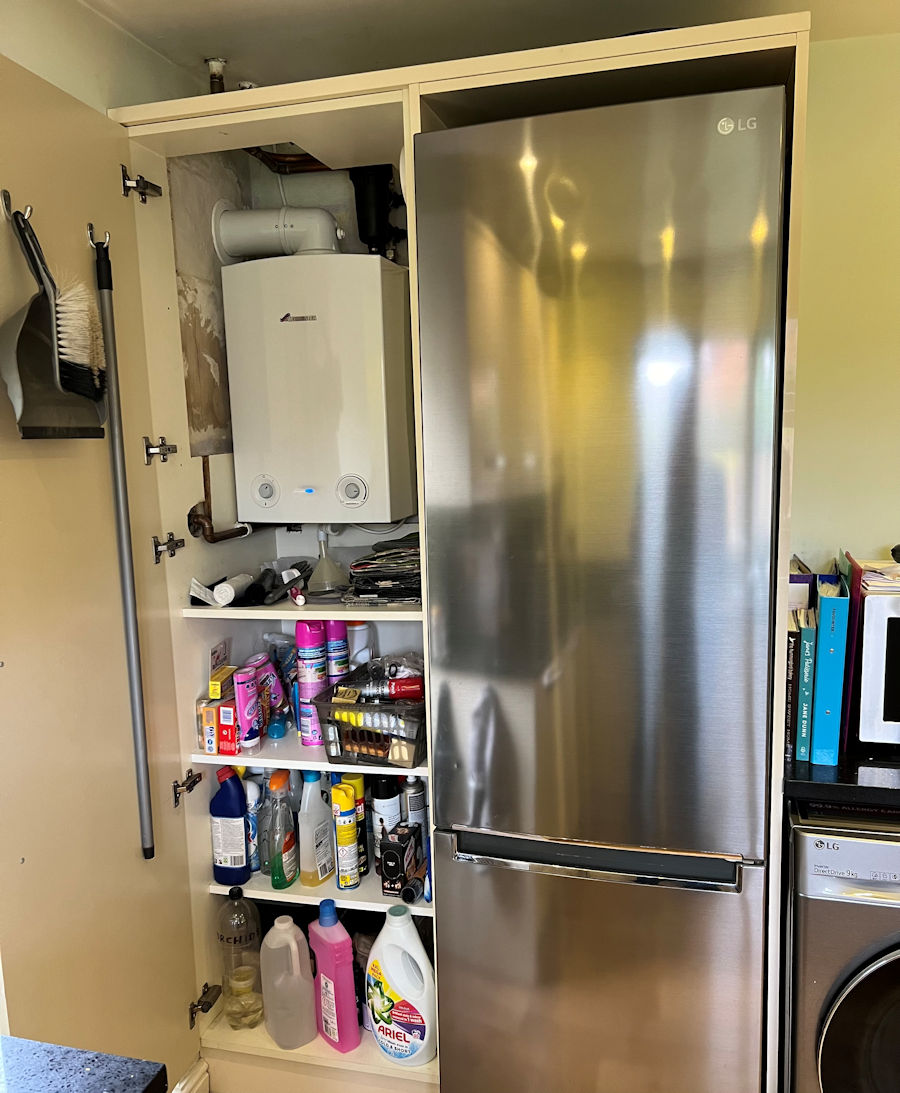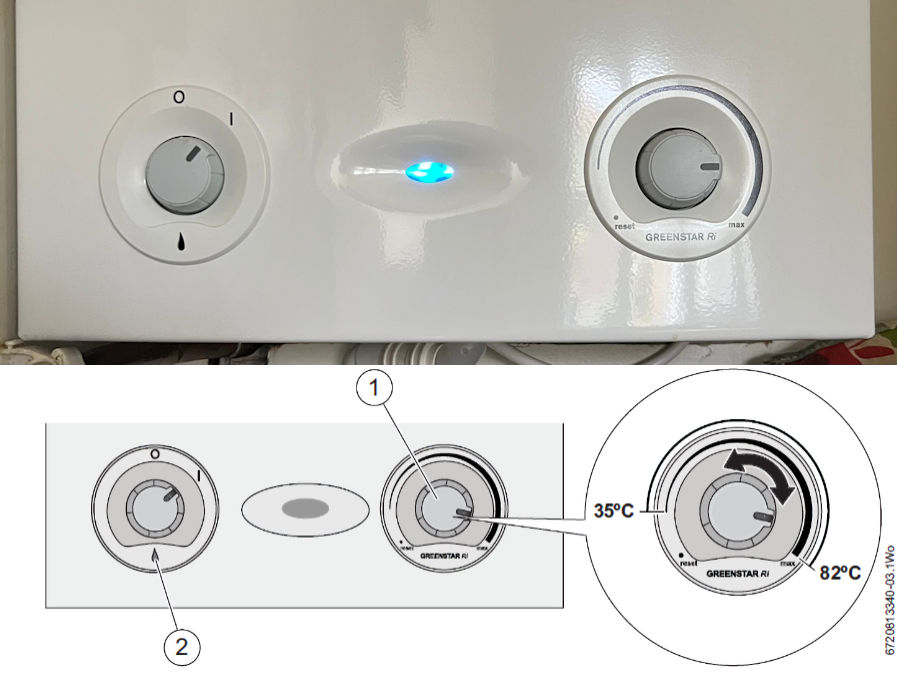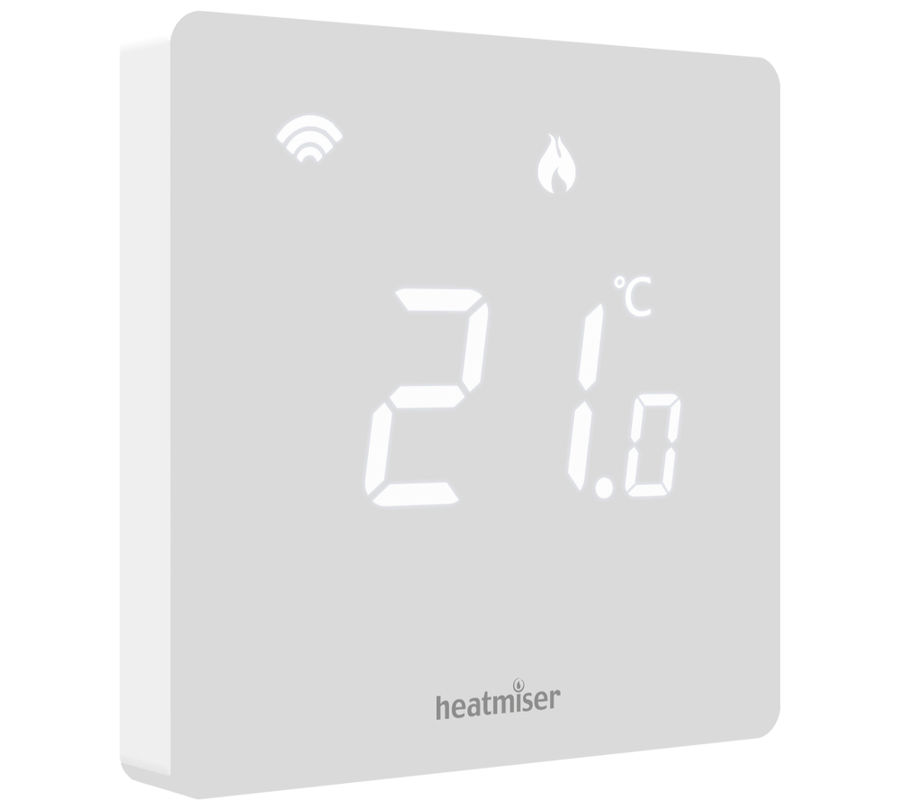House Extension HVAC Project

As part of our smart home extension, we are updating the central heating and hot water system for our whole home. We are also adding a split-head air conditioning system to the new open plan space and the new master bedroom. This is NOT an exercise in technology geekiness. As with all of my smart home work, the primary aim is to improve our quality of life.

We already have a large (6.63kW) solar array on the front roof of our home, which is South facing and at 40°. To provide even more renewable energy for the air conditioning, electric under floor heating, heated towel rails, etc. we are also fitting 'in roof' solar panels to cover the new East and West facing roof aspects. These will fit seamlessly with the planned Velux windows.
In 2023 we generated 7450kWh and aim to increase the annual generation to over 11MWh (11,000kWh). We have an electric vehicle and plan a second one in 2025. I am also converting a 1992 Eunos Roadster to an EV. We can charge these EVs with imported power or solar using our Zappi smart EV charger. We also have a Tesla Powerwall.

We are adding an air condition unit like this Fujitsu AOYG18KBTA2 system, to provide independent cooling over the summer in the open plan space and the new master bedroom above it. This unit can also provide efficient heating, using solar energy.
Air Source Heat Pump
I investigated swapping out the gas boiler to an Air-Source Heat Pump (ASHP) as part of the wider plans to update our home. We would need to update some of the existing radiators and the plan is to have wet underfloor heating in the new open-plan extension. We would also move to a number of separate heating/cooling zones:
- We don't really have space down the side of our house for an air source heat pump. The side path is the only direct entry point into our back garden and it is just 137cm wide.
- The only side of the house where a heat pump could be installed is next to a fence that borders my neighbour's garden. It would be too loud to inflict on them.
- The only other space available for an air source heat pump is in our back garden (at the end of the new utility room) and that would be too visible and audible for us.
- In order to fit a heat pump, we would have to rip up every floor in our home, to replace microbore pipes. This really would be too much disruption on top of having the extension built. We are assuming we need some unmolested space in our home, to live in whilst the extension work is completed.
- All of the radiators that are remaining would need to be replaced.
Office
The office/bedroom on the second floor (built into the new extension roof) will be a separate zone and will use electric underfloor heating. It will be completely isolated from the rest of the central heating system. The main reason for this is that the mains water pressure is not high enough to reach up to this room and there is no pipework currently higher than the hot water tank in the airing cupboard on the first floor. I realise that electric underfloor heating is generally expensive to run but, we are a net exporter of electricity and our total yearly energy bill (including EV charging) is less than £500. This space will not be used a lot either.
Drayton sell an underfloor heat switch which would work with my existing Drayton Wiser wireless thermostat.
Utility Room
We will use an electric only towel rail in the utility room as we don't plan or need to heat this space but, it needs some form of heating in place for building regs. The presence of the boiler and appliances should add some heat into this space. We want to keep it fairly cool because this space will be used for wine and food storage. There will also be a beer fridge in this space 😎
Zoned Heating
We now plan to split the house into the following zones, each fed from a new multi-port manifold:
- The new open-plan space with 53m² of wet underfloor heating under tiles.
- The rest of the downstairs, i.e. the front reception room (old lounge), entrance hall and toilet, using the existing radiators and towel rails.
- The whole of the first floor, which includes the new master bedroom and ensuite bathroom, two existing front bedrooms (one with an ensuite bathroom), the newly extended main bathroom, the existing study/bedroom and the landing.
- Hot water tank.
I think this means we require two or more ports for the open plan underfloor heating, as one UFH loop would be too long. All of the pipework that needs to be modified is 15mm/22mm copper pipe but, each individual radiator is fed via micro-bore copper pipe. Where is makes sense, we will be replacing the micro-bore. All new plumbing will be 15mm and 22mm and ideally copper pipe but, running copper pipe through some joists may not be possible.
Hot Water
Having decided to stick with our gas boiler, it makes sense to separate the hot water system/tank from the central heating. At the moment the hot water has to be on for the heating to work. This makes it harder to control and less flexible.
We will need a new hot water tank with a high power (3kW) heating element to allow solar energy to be used to heat it. I have already developed my own smart solar water heater controller but, initially we will fit a smart contactor to enable on/off control.
I plan to attach temperature sensors to the new hot water tank (as I have done to the current one) to enable smart analysis and intelligent control by my Home Control System.
Gas Boiler & Plumbing
We currently have a 'Worcester Bosch Greenstar 18Ri Erp + NG' condensing regular gas boiler for our space heating and hot water. We have no real reason to replace this as it was only installed in 2022 and is very efficient. It meets the building regulations in terms of efficiency. Our gas is also cheap, at around 6p/kWh on the Octopus Energy Tracker tariff. Our current system also includes an unvented (mains pressure) hot water storage tank.

As we are adding a utility room and the boiler sits within it, we now have much more space next to the boiler to add things like a multi-port manifold and the extra pipework required to support multiple zones. The space currently occupied by cleaning products, fridge/freezer and another 10-15cm more will be freed up.
Above this space is my study and the floor will need to come up here and across the width of the landing, in order to install the extra pipework required for the new heating zones.

It is possible to set the flow temperature of our gas boiler and it is currently set to about 77°C. It could be set as low as 50°C in this application.
- Our boiler can only see a demand from external components and has no way of recognising if it is a heating or hot water demand.
- There is a single connection in our boiler for demand via the wiring centre (LR = live return) which uses 230V signalling.
Hot Water
We plan to keep our gas boiler but, we will change the hot water cylinder to one that is heated directly and can also be heated using spare solar energy. This gives us flexibility when energy prices and tariffs change. It also allows us to heat water whilst off-grid, using solar energy and our Tesla Powerwall.
Control

We currently have a Drayton Wiser 2-channel controller and wireless (battery powered) smart thermostat and I have written a review on them. It works really well and has a nice API to enable intelligent control by my Home Control System.

My current plan is to have three wired and wall-mounted smart themostats (to avoid the need for batteries). My preferred solution is to use the Heatmiser neoStat Pro. These fit within a standard 35mm back box.
These thermostats link wirelessly to a Heatmiser Heatmiser neoHub.
Air Conditioning

We are adding an air condition unit like this Fujitsu AOYG18KBTA2 system, to provide independent cooling over the summer in the open plan space and the new master bedroom above it. In operation this will typically use less than 2kW.
Global warming has increased the number days each year where need to cool our home and we have also seen new record temperatures in the last few years. These hot days ALWAYS occur when we have high levels of solar energy generation, meaning we can run our air conditioning system on free solar energy. Because we generate decent amounts of electricity throughout the year, we can also use it to augment the heating in our home if required.
Requirements
Moving forward, I have a number of requirements:
- I would like to install a manifold next to the gas boiler, to enable proper multi-zone heating and hot water control. The main reason for doing this is to enable zones to be heated individually. Throughout the period from April to October, we only ever use hot water and the heating is basically off. There are times in Autumn and Spring, when we will only want to heat the open plan space. We never heat the first floor (mostly bedrooms) at night but, we may want to heat them briefly in the morning. The rest of the ground floor (everything outside the open plan space) will need very little heat input as it will be rarely used.
- I would like to install wall mounted and wired smart thermostats in the reception room (old lounge), open plan space and the new master bedroom.
- In the toilet, bathroom and two ensuite bathrooms we plan to fit combined radiators and towel rails, each with a smart 400W electric heater. This enables them to be used in the summer months as heated towel rails, even when the central heating system is off.
- All of the taps upstairs are being replaced with mixer taps, so we will not have the ridiculous situation of 60+°C water coming out of the (hot) taps!
Assumptions
- Our current home is pretty well insulated. We switch the central heating system off completely from April to October as it is simply not needed. Our smart home 'exercises' it once a week and we assume this will remain the case.
- The new air conditioning system will be completely independent from the new heating system and will capable of both heating and cooling. Only one of them will be used at any one time, to avoid any conflicts.
- Because of the large area (53m²) of open plan underfloor heating, I am assuming that it will need two or more loops.
- The gas boiler flow temperature can be lowered to enable it to run much more efficiently.
- The hot water tank can be raised above 60°C regularly using the electric immersion heater to kill unwanted bacteria. This can be timed to use the cheapest rate electricity or free solar electricity.
Understanding
This is my understanding of how multi-zone heating systems and condensing boilers work:
- The efficiency with a condensing boiler increases as the return flow temperature decreases. So in theory, it would run more efficiently if all the zones called for heat at the same time.
- A condensing gas boiler runs more efficiently if the flow/return temperature is reduced from 80/60 to around 70°/50° as it operates in condensing mode more often.
- Too many zones or too small a zone will not create the required differential in flow and return temperatures. A careful balance is required between the number of zones and the need for different areas of the house to be heated to different temperatures and at different times. In this respect, the new master bedroom and ensuite may not be a big enough zone to heat on its own. We may have to consider all of the rooms upstairs to be one heating zone.
- We now the hot water tank alone is fine as being the only "heated zone" as this is how it works at the moment. A lower flow temperature and tank temperature would considerably improve efficiency.
Future Proofing
Longer term, the UK is going to move away from gas for heating, so I'm taking steps to move in this direction. Whilst we are keeping our (recently installed) gas boiler, the addition of an air conditioning unit for both heating and cooling in our new main living space, should allow us to massively reduce the amount of gas used in our home. By splitting the house into three seperate heating zones, seperating the hot water tank and adding a manifold, I'm taking some steps towards making our home ready for a heat pump in the future.
The main steps needed in the part of the house that is not being touched as part of the new smart home extension, would be to replace the micro-bore piping and upgrade the radiators.


